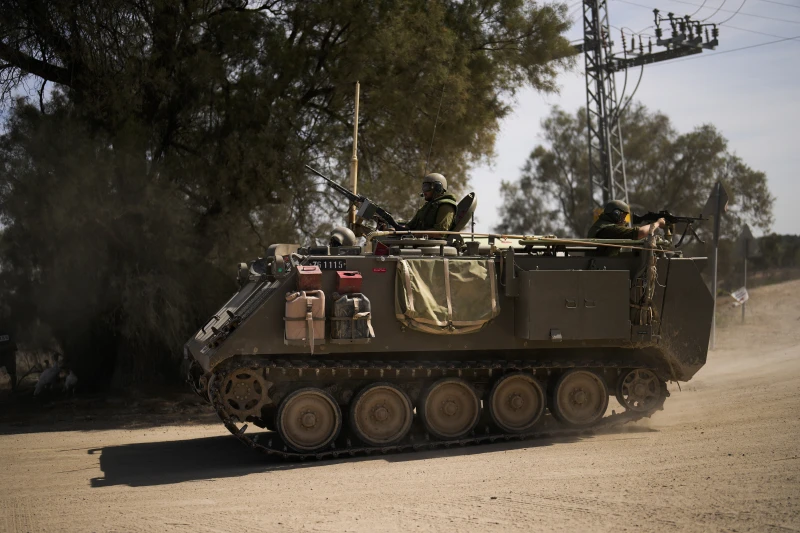Relief workers said far more aid was needed to address the spiraling humanitarian crisis in Gaza, where half the territory’s 2.3 million people have fled their homes. The U.N. humanitarian agency, known as OCHA, said Saturday’s convoy carried about 4% of an average day’s imports before the war and “a fraction of what is needed after 13 days of complete siege.”
The Israeli military said the humanitarian situation was “under control,” even as OCHA called for 100 trucks a day to enter.
Israel repeated its calls for people to leave northern Gaza, including by dropping leaflets from the air. It estimated 700,000 already fled. But hundreds of thousands remain. That would raise the risk of mass civilian casualties in any ground offensive.
Israeli military officials say Hamas’ infrastructure and underground tunnel system are concentrated in Gaza City, in the north, and that the next stage of the offensive will include unprecedented force there. Israel says it wants to crush Hamas. Officials have also spoken of carving out a buffer zone to keep Palestinians from approaching the border, though they have given no details.
Hospitals packed with patients and displaced people are running low on medical supplies and fuel for generators, forcing doctors to perform surgeries with sewing needles, using vinegar as disinfectant, and without anesthesia.
The World Health Organization says at least 130 premature babies are at “grave risk” because of a shortage of generator fuel. It said seven hospitals in northern Gaza have been forced to shut down due to damage from strikes, lack of power and supplies, or Israeli evacuation orders.
Shortages of critical supplies, including ventilators, are forcing doctors to ration treatment, said Dr. Mohammed Qandeel, who works in Khan Younis’ Nasser Hospital. Dozens of patients continue to arrive and are treated in crowded, darkened corridors, as hospitals preserve electricity for intensive care units.
“It’s heartbreaking,” Qandeel said.
Palestinians sheltering in U.N.-run schools and tent camps are running low on food and drinking dirty water. The lack of fuel has crippled water and sanitation systems. OCHA said cases of chickenpox, scabies and diarrhea are on the rise because of the lack of clean water.
Heavy airstrikes were reported across Gaza, including in the southern part of the coastal strip, where Israel has told civilians to seek refuge. At the Al-Aqsa hospital in Deir al-Balah, south of the evacuation line, several bodies wrapped in white shrouds were lined up outside.
Khalil al-Degran, a hospital official, said more than 90 bodies had been brought in since early Sunday, as the sound of nearby bombing echoed behind him. He said 180 wounded people had arrived, mostly children, women and the elderly displaced from other areas.
Airstrikes also smashed through the marketplace in the Nuseirat refugee camp. Witnesses said at least a dozen people were killed.
Israel’s military has said it is striking Hamas fighters and installations, and does not target civilians. Palestinian militants have fired over 7,000 rockets at Israel, according to the military, and Hamas says it targeted Tel Aviv early Sunday.
More than 1,400 people in Israel have been killed — mostly civilians slain during the initial Hamas attack. At least 212 people were captured and dragged back to Gaza.
Two Americans were released on Friday, hours before the first shipment of humanitarian aid.
More than 4,600 people have been killed in Gaza, according to the Hamas-run Health Ministry. That includes the disputed toll from a hospital explosion.
U.S. Secretary of State Antony Blinken told CBS’ “Face the Nation” that Hamas was responsible, not just for its brutal rampage in southern Israel, but for the deaths of civilians in Israel’s attacks on Gaza. “It knew that in Israel’s necessary response, civilians would be caught in that crossfire,” he said.
He said the militants were operating among the civilian population and its tunnels were buried under hospitals and schools. “What does anyone expect Israel to do?” he said.
“This is on Hamas.”
Syrian state media, meanwhile reported that Israeli airstrikes hit the international airports in the capital, Damascus, and the northern city of Aleppo, killing one person and putting the runways out of service.
Israel has carried out several strikes in Syria since the war began. Israel rarely acknowledges individual strikes, but says it acts to prevent Hezbollah and other militants from bringing in arms from Iran, which also supports Hamas.
In Lebanon, Hezbollah said six fighters were killed Saturday, and the group’s deputy leader, Sheikh Naim Kassem, warned that Israel would pay a high price if it invades Gaza. Israel struck Hezbollah in response to rocket fire, the military said.
Israel also announced evacuation plans for another 14 communities near the Lebanon border.
In the Israeli-occupied West Bank, 93 Palestinians have been killed — including eight Sunday — in clashes with Israeli troops, arrest raids and attacks by Jewish settlers since the Hamas attacks, according to the Palestinian Health Ministry. Israeli forces have closed crossings into the territory and checkpoints between cities, measures they say are aimed at preventing attacks. Israel says it has arrested more than 700 Palestinians since Oct. 7, including 480 suspected Hamas members.
Among the dead were two killed in an airstrike on a mosque in the town of Jenin, which has seen heavy gun battles over the past year. The Israeli military said the mosque compound belonged to Hamas and Islamic Jihad militants who had carried out several attacks in recent months and were planning another.
The internationally recognized Palestinian Authority administers parts of the West Bank and cooperates with Israel on security, but it is deeply unpopular and has been the target of violent Palestinian protests.



